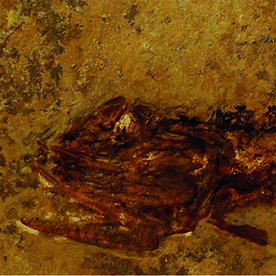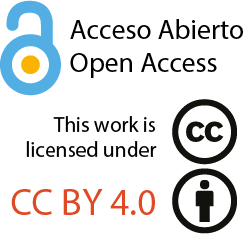PALEONTOLOGICAL RECORD OF A GONDWANA CRETACEOUS PALEOLAKE AS PROXY FOR PALEOCLIMATE RECONSTRUCTION
DOI:
https://doi.org/10.5710/PEAPA.17.04.2023.454Keywords:
La Cantera Formation, Lacustrine, Underfilled lake, Stable isotopes, Fossil fish, Fossil plantAbstract
The La Cantera Formation (Aptian) represents an underfilled lake system developed in an extensional basin during the Cretaceous hothouse and it bears an abundant and diverse fossil record. Our goal was to investigate paleoclimate conditions of the unit from a multiproxy approach. We analyzed two proxies: a) the stable isotope (carbon and oxygen) composition of basal Actinopterygii and Neopterygii fish remains and from indeterminate plant remains; and b) the clay mineral assemblage composition; providing two independent lines of evidence to reconstruct paleoclimate conditions including paleotemperature calculations for lake waters. The values obtained for fish remains for δ13C range between -8.4 and -1.3 ‰ (δ13C= χ -5.57‰; σ ± 2.25); and δ18O values that vary between -5.7 and -3.6‰ (δ18O= χ -4.33‰; σ ± 0.84); in the case of plant remains δ13C values range between -25.8 and -22.8‰ (δ13C= χ -25‰ -4.33). Paleotemperatures obtained from δ18O for the water column ranged between 23.33 to 35.80 °C. Plant δ13C signature allowed obtaining a δ13CCO2 composition of -5 ‰. This agrees with the interpretation of the La Cantera originating from sediment deposition in an underfilled lake basin and with the global climate context of the Cretaceous. The clay mineral assemblage is dominated by illite-smectite indicating enhanced hydrolysis and seasonal rainfall supporting temporal warmup of the lake. Our data supports aridity conditions during the La Cantera paleolake existence. These findings suggest that geochemical proxies of paleontological datasets are accurate for paleoclimate reconstructions for the deep time records of the La Cantera lacustrine system.
References
Abell, P. I., Awramik, S. M., Osborne, R. H. and Tomellini, S. (1982). Plio-pleistocene lacustrine stromatolites from lake Turkana, Kenya: Morphology, stratigraphy and stable isotopes, Sedimentary Geology, 32(1–2): 1–26, doi.org/10.1016/0037-0738(82)90011-2.
Arcucci, A. B., Prámparo, M. B., Codorniú, L., Giordano, P. G., Castillo Elías, G., Puebla, G., Mego, N., Gomez, M. and Bustos Escalona, E. (2015). Biotic assemblages from Lower Cretaceous lacustrine systems, San Luis Basin, central-western Argentina. Boletín Geológico y Minero de España, 126(1): 109–128.
Arens, N. C. and Jahren, A. H. (2000). Carbon isotope excursion in atmospheric CO2 at the Cretaceous–Tertiary boundary: Evidence from terrestrial sediments, Palaios, 15: 314–322.
Amiot, R., Wang, X., Lécuyer, C., Buffetaut, E., Boudad, L., Cavin, L. and Zhang, F. (2010). Oxygen and carbon isotope compositions of middle Cretaceous vertebrates from North Africa and Brazil: Ecological and environmental significance. Palaeogeography, Palaeoclimatology, Palaeoecology, 297(2): 439–451.
Barrenechea, J. E., López-Gómez, J. and De La Horra, R. (2018). Sedimentology, clay mineralogy and palaeosols of the mid-Carnian Pluvial Episode in eastern Spain: insights into humidity and sea level variations. Journal of the Geological Society, 175: 993–1003.
Benavente, C. A., Mancuso, A. C., Cabaleri, N. G., and Gier¬lowski-Kordesch, E. H. (2015). Comparison of lacustrine successions and their paleohydrologic implications in the two sub-basins of the Triassic Cuyana rift, Argen¬tina, Sedimentology 62: 1771–1813, doi .org/10.1111/sed.12209.
Benavente, C. A., Mancuso, A. C. and Bohacs, K. M. (2019). Paleohydrogeologic reconstruction of Triassic carbonate paleolakes from stable isotopes: Encompassing two lacustrine models, Journal of South American Earth Sciences 95: 102292.
Benavente, C. A., Mancuso, A. C., Irmis, R. B., Bohacs, K. M. and Matheos, S. (2022). Tectonically conditioned record of continental interior paleoclimate during the Carnian Pluvial Event: the Upper Triassic Los Rastros Formation, Argentina. Geological Society of America Bulletin, 134(1–2): 60–80, doi.org/10.1130/B35847.1
Benavente, C. A., Mancuso, A. C. and Bohacs, K. M. (2021). Chapter 14, Reconstructing paleoenvironmental conditions through integration of paleogeography, stratigraphy, sedimentology, mineralogy, and stable isotope data of lacustrine carbonates—an example from early Middle Triassic strata of southwest Gondwana, Cuyana Rift, Argentina. In Rosen, M. R., Park-Bousch, L., Finkelstein, D. B. and Pla-Pueyo, S. (Eds.) Limnogeology: Progress, challenges and opportunities: A tribute to Beth Gierlowski-Kordesch, Springer International Publishing, pp. 471–509, doi.org/10.1007/978-3-030-66576-0_16
Bergner, A. G. N., Strecker, M. R., Trauth, M. H., Deino, A., Gasse, F., Blisniuk, P. and Dühnforth, M. (2009). Tectonic and climatic control on evolution of rift lakes in the central Kenya Rift, East Africa: Quaternary Science Reviews 28: 2804–2816
Beerling, D. J. and Woodward, F. I. (1995). Leaf Stable Carbon Isotope Composition Records Increased Water-Use Efficiency of C3 Plants in Response to Atmospheric CO2 Enrichment. Functional Ecology 9(3): 394–401.
Bessems, I., Verschuren, D., Russell, J. M., Hus, J., Mees, F. and Cumming, B. F. (2008). Palaeolimnological evidence for widespread late 18th century drought across equatorial East Africa: Palaeogeography, Palaeoclimatology, Palaeoecology 259: 107–120
Bohacs, K. M., Carroll, A. R., Neal, J. E. and Mankiewicz, P. J. (2000). Lake-basin type, source potential, and hydrocarbon character: an integrated sequence-stratigraphic-geochemical framework. Lake basins through space and time: AAPG Studies in Geology 46: 3–34.
Bowen, G. J. and Wilkinson, B. (2002). Spatial distribution of δ18O in meteoric precipitation, Geology 30: 315–318
Castillo Elías, G. (2016). Aspectos paleoecológicos y sedimentológicos de la Formación La Cantera, Sierra del Gigante, Aptiano Tardío, Sierras de San Luis. Thesis Universidad Nacional de San Luis, 270 p.
Chamley, H. (1989). Clay Sedimentology. Springer, Berlin, 623 p.
Cerling, T. E., Bowen G. J., Ehleringer J. R. and Sponheimer, M. (2007). The reaction progress variable and isotope turnover in biological systems. Terrestrial Ecology, 1: 163–171.
Craig, H. (1954). Carbon 13 in plants and the relationships between carbon 13 and carbon 14 variations in nature. The Journal of Geology, 62 (2): 115–149.
Criado-Roque P., Mombrú C. and Moreno J. (1981). Sedimentitas mesozoicas. Geología de la Provincia de San Luis. Relatorio del VIII Congreso Geológico Argentino, Argentina, pp. 79–96.
Do Campo, M., del Papa, C., Nieto, F., Hongn, F. and Petrinovic, I. (2010). Integrated analysis for constraining palaeoclimatic and volcanic influences on clay–mineral assemblages in orogenic basins (Palaeogene Andean foreland, Northwestern Argentina). Sedimentary Geology, 228(3–4): 98–112.
Farquhar, G. D., Hubick, K. T., Condon, A. G. and Richards, R. A. (1989) Carbon isotope fractionation and plant water-use efficiency. In Rundel, W., Ehleringer, J. R. and Nagy K. A. (Eds.), Stable isotopes in ecological research, 68: 21–40. Springer.
Fetrow, A. C., Snell, K. E., Di Fiori, R. V., Long, S. P., and Bonde, J. W. (2022). How hot is too hot? Disentangling mid-Cretaceous hothouse paleoclimate from diagenesis. Paleoceanography and Paleoclimatology, 37, e2022PA004517.
Flores, M. A. (1969). El Bolsón de las Salinas en la provincia de San Luis. Jornadas Geológicas Argentinas, Abstract, 1: 311–327.
Fürsich, F. T., Singh, I. B., Joachimski, M., Krumm, S., Schlirf, M., Schlirf, S. (2005). Palaeoclimate reconstructions of the Middle Jurassic of Kachchh (western India): an integrated approach based on palaeoecological, oxygen isotopic, and claymineralogical data. Palaeogeography, Palaeoclimatology, Palaeoecology, 217: 289–309.
Gierlowski-Kordesch E. y Kelts K. 1994. Global geological record of lake basins. Cambridge University Press, 427 p.
Giordano, P. G. (2017). Diversity of Cretaceous continental actinopterygians from Argentina, South America. Research and Knowledge 3(2): 1–8.
Giordano, P. G.; Arratia, G. and Schultze, H. P. (2016). Scale morphology and specialized dorsal scales of a new teleosteomorph fish from the Aptian of West Gondwana. Fossil Record 19: 61–81.
Grande, L. (2010). An empirical synthetic pattern study of gars (Lepisosteiformes) and closely related species, based mostly on skeletal anatomy. The resurrection of Holostei. Copeia, 10(2A): 1.
Grimes, S. T.; Mattey, D. P.; Hooker, J. J. and Collinson, M. E. (2003). Paleogene paleoclimate reconstruction using oxygen isotopes from land and freshwater organisms: the use of multiple paleoproxies. Geochimica et Cosmochimica, 67(21): 4033–4047.
Gröcke, D. R. (2002). The carbon isotope composition of ancient CO2 based on higher-plant organic matter. Philosophical Transactions of the Royal Society of London A, 360: 633–658
Huijzer, B. and Vandenberghe, J. (1998). Climatic reconstruction of the Weichselian Pleniglacial in northwestern and central Europe. Journal of Quaternary Science, 13(5): 391–417.
Iacumin, P.; Bocherens, H.; Mariotti, A. and Longinelli, A. (1996). Oxygen isotope analyses of co-existing carbonate and phosphate in biogenic apatite: a way to monitor diagenetic alteration of bone phosphate. Earth and Planetary Science Letters, 142(1–2): 1–6.
Kolodny, Y.; Luz, B. and Navon, O. (1983). Oxygen isotope variations in phosphate of biogenic apatites, I. Fish bone apatite—rechecking the rules of the game. Earth and Planetary Science Letters, 64(3): 398–404.
Leng, M. J.; Lamb, A. L.; Heaton, T. H. E.; Marshall, J. D.; Wolfe, B. B.; Jones, M. D.; Holmes, J. and Arrowsmith, A. (2005). Isotopes in lake sediments. Isotopes in palaeoenvironmental research, 147–184.
Liu, B.; Wan, W.; Xie, H.; Li, H.; Zhu, S.; Zhang, G. and Hong, Y. (2019). A long-term dataset of lake surface water temperature over the Tibetan Plateau derived from AVHRR 1981–2015. Scientific data, 6(1): 48.
Longinelli, A. and Nuti, S. (1973). Oxygen isotope measurements of phosphate from fish teeth and bones. Earth and Planetary Science Letters, 20(3): 337–340.
Ludvigson, G.A., Joeckel, R.M., Murphy, L.R., Stockli, D.F., Gonzalez, L.A.,
Suarez, C.A., Kirkland, J.I., Al-Suwaidi, A. (2015). The emerging terrestrial record of Aptian-Albian global change. Cretaceous Research, 56: 1–24.
Michener, R. and Lajtha, K. (2008). Stable isotopes in ecology and environmental science. John Wiley & Sons, 594 p.
Moernaut, J.; Verschuren, D.; Charlet, F., Kristen, I.; Fagot, M. and De Batist, M. (2010). The seismic-stratigraphic record of lake-level fluctuations in Lake Challa: hydrological stability and change in equatorial East Africa over the last 140 kyr: Earth and Planetary Science Letters, 290: 214–223.
Moore, D. M. and Reynolds Jr. R. C. (1997). X-Ray Diffraction and the Identification and Analysis of Clay Minerals. Oxford University Press, Oxford 337 p.
Pereira, N. S.; Sial, A. N.; Pinheiro, P. B.; Freitas, F. L. and Silva, A. (2021). Carbon and oxygen stable isotopes of freshwater fish otoliths from the São Francisco River, northeastern Brazil. Anais da Academia Brasileira de Ciências, 93: e20191050.
Petruleviĉius J., Nel A. and Sallenave S. (2010). Recent genus Notonecta (Insecta: Heteroptera: Notonectidae) in the Lower Cretaceous of San Luis, Argentina: Palaeoecological implications. International Journal of Entomology, 46:1–2.
Prámparo, M. B. (1994). Lower Cretaceous palynoflora of the La Cantera Formation, San Luis Basin: correlation with other Cretaceous palynofloras of Argentina. Cretaceous Research, 15(2): 193–203.
Prámparo, M. B. (2012). Non-marine Cretaceous palynomorph biostratigraphy of Argentina: a brief summary. Journal of Stratigraphy, 36: 213–228.
Prámparo, M. B., Vento, B., Narváez, P. L., Mego, N. and Puebla, G. G. (2018). Cretaceous climatic reconstruction from Argentina based on palynological data. Boletín Geológico Minero, 129: 615–631.
Pucéat, E., Joachimski, M. M., Bouilloux, A., Monna, F., Bonin, A., Motreuil, S. and Quesne, D. (2010). Revised phosphate–water fractionation equation reassessing paleotemperatures derived from biogenic apatite. Earth and Planetary Science Letters, 298(1–2): 135–142.
Puebla, G. (2009). A new angiosperm leaf morphotype from the Early Cretaceous (Late Aptian) of San Luis Basin, Argentina. Ameghiniana, 46: 557–566.
Puebla, G., Mego, N. and Prámparo, M. (2012). Asociación de Briófitas de la Formación La Cantera, Aptiano Tardío, Cuenca de San Luis, Argentina. Ameghiniana, 49(2): 217–229.
Qu, Q., Haitina, T., Zhu, M. and Ahlberg, P. E. (2015). New genomic and fossil data illuminate the origin of enamel. Nature, 526(7571): 108–111.
Rey, K., Day, M. O., Amiot, R., Fourel, F., Luyt, J., Lécuyer, C. and Rubidge, B. S. (2020). Stable isotopes (δ18O and δ13C) give new perspective on the ecology and diet of Endothiodon bathystoma (Therapsida, Dicynodontia) from the late Permian of the South African Karoo Basin. Palaeogeography, Palaeoclimatology, Palaeoecology, 556: 109882.
Rivarola, D. and Spalletti, L. (2006). Modelo de sedimentación continental para el rift Cretácico de la Argentina central. Ejemplo de la Sierra de Las Quijadas, San Luis. Revista de la Asociación Geológica Argentina, 61(1): 63–80.
Salduondo, J., Comerio, M., Pineda, J.A., Cravero, F. and Erra, G. (2022). Palaeoclimatic and diagenetic controls based on clay mineralogy and organic matter distribution: The continental rift Cuyo Basin (Triassic), west-central Argentina. Sedimentology, 69: 2867–2896
Schultze, H. P. (2018). Hard tissues in fish evolution: history and current issues. Cybium 42(1): 29–39.
Schultze, H. P. (2016). Scales, enamel, cosmine, ganoine, and early osteichthyans. Comptes Rendus Palevol, 15(1–2): 83–102.
Schultze H. P. (1996). Morphologische und histologische Untersuchungen an Schuppen mesozoischer Actinopterygier (Übergang von Ganoid zu-Rundschuppen). Neuss Jahrbuch für Geologie und Palaontologie, 126(3): 232–314.
Singer, A. 1984. The paleoclimatic interpretation of clay minerals in sediments—a review. Earth-Science Reviews, 21(4): 251–293.
Sisma-Ventura, G., Tütken, T., Peters, S; T., Bialik, O. M., Zohar, I. and Pack, A. (2019). Past aquatic environments in the Levant inferred from stable isotope compositions of carbonate and phosphate in fish teeth. Plos one 14(7): e0220390.
Tieszen, L. ., Boutton, T. W., Tesdahl, K. G. (1983). Fractionation and turnover of stable carbon isotopes in animal tissues: Implications for δ13C analysis of diet. Oecologia 57, 32–37, https://doi.org/10.1007/BF00379558
Tütken, T., Vennemann, W., Janz, H. and Heizmann, E. P. J. (2006). Palaeoenvironment and palaeoclimate of the Middle Miocene lake in the Steinheim basin, SW Germany: A reconstruction from C, O, and Sr isotopes of fossil remains. Palaeogeography, Palaeoclimatology, Palaeoecology, 241(3–4, 14): 457–491.
Ufnar, D. F., González, L. A., Ludvigson, G. A., Brenner, R. L. and Witzke, B. J. (2004). Evidence for increased latent heat transport during the Cretaceous (Albian) greenhouse warming. Geology, 32(12): 1049–1052
van Hinsbergen, D. J., de Groot, L. V., van Schaik, S. J., Spakman, W., Bijl, P. K., Sluijs, A. and Brinkhuis, H. 2015. A paleolatitude calculator for paleoclimate studies. Plos one, 10(6): e0126946.
Wang, L., Scarpitta, S. C., Zhang, S. C. and Zheng, M. P. (2002). Later Pleistocene/Holocene climate conditions of Qinghai–Xizhang Plateau (Tibet) based on carbon and oxygen stable isotopes of Zabuye Lake sediments, Earth and Planetary Science Letters 203(1): 461–477.
West, J. B., Bowen, G. J., Cerling, T. E. and Ehleringer, J. R. (2006). Stable isotopes as one of nature's ecological recorders. Trends in Ecology, 21(7): 408–414.
Woolway, R. I. and Merchant, C. J. (2017). Amplified surface temperature response of cold, deep lakes to inter-annual air temperature variability: Scientific Reports, 4(7): 1–8,
Fish Base: https://www.fishbase.se/search.php

Additional Files
Published
Issue
Section
License
Copyright (c) 2023 Cecilia Andrea Benavente, Juan I. Balaguer-Gasull, Paula Guillermina Giordano, Adriana Cecilia Mancuso, Andrea Beatriz Arcucci

This work is licensed under a Creative Commons Attribution-NoDerivatives 4.0 International License.
Authors retain copyright and grant the journal right of first publication with the work simultaneously licensed under a Atribución/Reconocimiento 4.0 Internacional that allows others to share the work with an acknowledgement of the work's authorship and initial publication in this journal.















